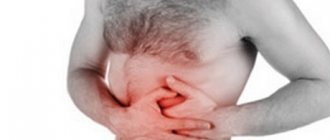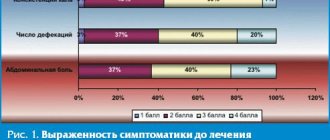Abdominal pain in children is difficult to recognize. Infants and children do not know how to complain about specific symptoms. At 5 years old, a completely conscious patient understands what pain is and points to the place with his finger. If a child has a stomach ache in the navel area, then the observation of adults is necessary to find out.
Usually, behavioral disturbances, irritability, tearfulness to the point of screaming, diarrhea or constipation, and other additional signs come to the fore. They help in diagnosing the causes.
Attentive parents are interested in how to recognize dangerous pain caused by pathology of the digestive tract. We will try to provide information about the most significant diseases in childhood, manifested by a complaint from the baby - “stomach pain in the navel area.”
More details about the problem
Abdominal pain is one of the most common childhood complaints, and fortunately, it is mostly temporary and harmless. Possible causes are varied and range from infections and food intolerances to functional discomfort.
Among the main provoking factors:
- digestive problems;
- intestinal infection;
- lack of bowel movement for several days;
- too fatty or sweet foods, as well as spoiled foods.
Mental problems, fears and stress also manifest as discomfort. It is usually harmless and will go away when the cause is eliminated. In addition, the body's reaction to excitement, anxiety or joyful excitement can also cause this symptom. Most often, the problem disappears quickly and does not require medical intervention.
What do we have to do
It is extremely dangerous to refuse hospitalization if you have severe pain in the abdominal area, especially on the left, right and bottom. Watch for signs of discomfort, note the location of severe pain, its frequency, and accompanying symptoms.
Do not self-diagnose or prescribe medications. Complete a course of therapy and examination in a hospital. If your doctor allows you to be treated at home, follow these recommendations:
- Give your baby bed rest. Do not prevent the patient from taking a comfortable position for sleeping and lying down. The child instinctively tucks his knees and curls up into a ball to feel less discomfort. Allow at least ten to fourteen hours a day to sleep. Do not allow jumping or playing active games for at least a couple of days.
- Increase the amount of fluid you drink. Vomiting and diarrhea dehydrate the body, give the child small portions of water, but often. As a drink, you can use chamomile tea, infusions of raspberries, currants, unsweetened compotes, and diluted lemon juice. You cannot drink soda or sweet juices.
- Set up a diet plan.
The nutritional pattern is very important for gastrointestinal diseases and intestinal pathologies at any age. To simplify the process, create a menu for the week, make sure your diet is rich in vitamins and minerals. - You need to take medications as prescribed by your doctor. To reduce the temperature, use syrups and age-appropriate tablets. This is Nurofen, ibuprofen, paracetamol. Avoid aspirin. Antibiotics are prescribed in tablets and injections according to indications.
- Use folk remedies to stop diarrhea, nausea, and vomiting. The stool is normalized by consuming oatmeal jelly. Digestion improves and nausea decreases if you drink olive or flaxseed oil. To restore strength after poisoning, it is recommended to give the child an infusion of rosehip, dill sprigs, and nettle.
- Fight colic and flatulence in newborns. Drink dill water, “Sub Simplex”, “Bobotik”, “Smecta” syrups. The medication should be taken before meals and at night.
- For bacterial infections, use honey. Add it to tea, let's eat a small spoon in the evening and in the morning.
- Remove parasites. For adults and children from six months of age, "Pyrantel" in tablets is used, "Piperazine" - from a year, "Albendazole" is allowed from 2 years.
What causes abdominal pain in a child?
Abdominal pain can also be dangerous - it can act as a signal of a serious illness, such as appendicitis, a urinary tract infection, or an inflammatory process in the pelvic area. It may even indicate incipient pneumonia. The cause may be an increase in body temperature or a flu-like condition. Rare predisposing factors are poisoning, helminthic diseases and intestinal colic.
In infants and young children, the cause is often difficult to determine. Signs include whining or crying, refusing to eat, pulling up the legs, vomiting or diarrhea, and extreme sensitivity to touch. Older children usually describe their feelings well. You can try to help your child with home remedies. If the discomfort does not subside, it is very strong, and if even after a bowel movement the condition does not improve, then the help of a specialist is needed.
Diet
Food is an important element in the treatment of intestinal diseases. Incorrectly selected and prepared products can provoke an exacerbation of the disease and reduce the effectiveness of treatment of gastrointestinal pathologies.
If you have abdominal pain, organize your children's diet according to the following rules:
- Eliminate everything fatty, sweet, sour, salty.
- In case of poisoning, dairy products, sausages, and canned food are prohibited.
- With colic, mothers and babies on breastfeeding should not eat fermenting fruits and vegetables.
- Do not fry the dishes, but boil or steam them.
- Give a child with dysbiosis natural yoghurts to restore the intestinal microflora.
- Make the menu from light dishes.
- Cook soups with chicken and low-fat beef broth.
- Do not force your child to eat if he categorically refuses. One or two days on a fasting diet for abdominal pain helps to recover. When the baby wants to eat, he himself will demand lunch.
- Remove red foods from the menu: apples, tomatoes, berries.
- Feed your baby in small portions, five to six times a day.
- After recovery, switch to a regular diet gradually.
Nature and areas of localization
In infants in the first 3-4 months of life, repeated abdominal pain, which often occurs at the same time of day or night and leads to strong cries, is characteristic of the so-called “three-month colic”. Often, gentle massage or stroking will relieve discomfort. In any case, contact your pediatrician to rule out other causes.
Table - Types and characteristics of abdominal pain in a child
| View | Visceral | Somatic |
| Character | Spastic | Acute, intense, constant, progressive with movement. |
| Localization area | Spilled, unlocalized | Local (within the pathological process) |
| Duration | From a few minutes to several months | Constant |
| Irradiation | Gives to the leg, arm, shoulder blade | Appears only in cases of high intensity and corresponds to the affected organ. |
| Sensations on palpation | In the area of pain localization | In the area of the affected organ |
| Associated symptoms | Tachycardia, excessive sweating, pale skin, vomiting | Typically absent |
In children of early and middle school age, if discomfort appears, you can observe for a while. As a rule, abdominal pain is localized in the navel area, occurs only during the day and is sometimes accompanied by bloating, as well as alternating constipation and diarrhea.
You should contact your pediatrician if your child experiences the following symptoms:
- periodic pain in the same place away from the navel;
- waking up at night due to discomfort in the abdominal area;
- colicky attacks, which are accompanied by sweating;
- discomfort during urination;
- persistent or frequent diarrhea for 4 weeks;
- blood in the stool, repeated vomiting, streaks of blood or bile juice in the vomit;
- noticeable weight loss, lack of weight gain, or stunted growth;
- prolonged increase in temperature.
Possible causes with warning symptoms include intestinal diseases, such as inflammation, celiac disease (gluten intolerance), food allergies, narrowing of the intestine, kidney malformations, kidney or gallstones, inflammation of the pancreas and other rare abdominal diseases.
Many children have no organic cause for their discomfort. Rather, there is a special sensitivity to bowel movements (overexcitation or irritation of the walls).
Bloating
Occurs due to gas formation in the gastrointestinal tract. It can develop in infants because they swallow a lot of air while sucking and drinking. Babies who eat high-fiber foods and eat plenty of vegetables and fruits are more likely to experience this condition.
If a child is prone to flatulence, a lot can be done for prevention and relief:
- purchase the right bottle and special drops that reduce gas formation;
- massage around the navel clockwise;
- provide sufficient time to chew food thoroughly;
- for prevention, give infusion of fennel, anise and caraway tea;
- minimize the amount of gas-causing foods (cabbage or legumes).
Gymnastic exercises - for example, lying on your back with your legs in the air "riding a bicycle" - as well as walking in the air, help improve the condition.
Constipation pain
Characterized by rare passage and hardening of feces. The child constantly complains of discomfort during bowel movements, so he is reluctant to go to the toilet. The situation could become a real problem.
To alleviate the condition, it is recommended:
- move a lot and drink enough;
- Eat a high-fiber diet with plenty of fruits, vegetables and whole grains;
- eat soaked dried fruits, flaxseed, wheat bran and yogurt;
- take warm relaxing baths.
Epigastric pain
Discomfort in the upper abdomen may come from one of the organs located there. These include the stomach, duodenum, liver, gallbladder, spleen (left behind the stomach) and pancreas (center behind the stomach).
The causes in children of middle school and adolescence in 50-70% of cases are:
- Heartburn, reflux disease. A burning, ascending pain behind the sternum, in the upper abdomen and possibly up to the neck, as well as temporary sour belching are the leading symptoms. Most often they occur after a heavy meal. With repeated contact with aggressive stomach acid, the lining of the esophagus can become inflamed (reflux esophagitis).
- Irritation of the gastric mucosa. Discomfort is manifested by convulsive attacks that do not depend on food intake. A feeling of fullness, bloating and loss of appetite are often added.
- Inflammation of the gastric mucosa. Common signs of gastritis include a feeling of fullness, lack of appetite, nausea, vomiting, heartburn, belching and bad breath.
- Stomach ulcer. Severe discomfort in the center or left side, which occurs almost immediately after eating. Over time, the discomfort subsides (often until the next meal).
- Duodenal ulcer (duodenal ulcer). Symptoms appear on an empty stomach and occur suddenly at night or a few hours after eating in the upper middle part. The condition improves after eating.
Due to its anatomical proximity to the chest, discomfort in the upper region can also be a sign of pneumonia. Problems in the spine also sometimes cause discomfort that radiates to the stomach.
When you need an urgent visit to the doctor
A pale appearance, constant screaming or crying, a curved or retracted stomach usually signals that you need to consult a specialist. Often, when a child has abdominal pain, the body temperature may increase. If the condition does not improve after about an hour or the attack recurs, you should consult a pediatrician or surgeon.
Emergency conditions requiring medical consultation include:
- diarrhea, bloody stools, fever, vomiting, chills;
- severe tension in the abdominal wall;
- prolonged crying and lethargy.
It is unacceptable to take action without making a diagnosis. Pain in the middle of the abdomen in children may indicate an umbilical hernia. In this case, there is a need for surgical intervention.
Treatment of reactive pancreatitis in children
If symptoms of pancreatitis appear, you should immediately consult a doctor. Some forms of pancreatitis require intensive care in a hospital setting!
Diagnosis of the disease is carried out using a blood test (biochemistry) and ultrasound examination of the abdominal cavity. If the diagnosis is determined correctly, then the treatment of reactive pancreatitis in children has the same principles as the treatment of the acute form of the disease.
The treatment mechanism for reactive pancreatitis includes diet and complex drug therapy. These could be antibiotics, enzymes, antihistamines - the correct drug treatment regimen should be determined by a doctor.
What to give a child for stomach pain?
If a child complains of pain in the abdomen, then help is needed. Please note that painkillers “blur” the picture of a serious surgical disease, which is fraught with the development of serious complications. Taking analgesics is possible only if surgical pathology is excluded.
If the reason is known, then act within the developed scenario:
- if the walls of the stomach or esophagus are irritated, give antacids (“Almagel”, “Maalox”);
- for food intoxication - sorbents;
- to reduce high temperatures - a drug based on paracetamol or Nurofen (if surgical pathology is excluded).
In conditions such as intestinal obstruction and acute pancreatitis, emergency medical attention is required. You need to call an ambulance if a child has appendicitis, which is accompanied by a sharp, cramping pain in the lower abdomen on the right, radiating to the right leg. In this case, medications are contraindicated because they interfere with emergency surgery, which is necessary in this case.
Diagnostics
During a physical examination, a gastroenterologist performs superficial and deep palpation, assesses areas of greatest pain, and pays attention to signs of impaired nutritional status. To identify the causes of pain in the navel area, laboratory and instrumental studies are prescribed. The diagnostic plan includes:
- Radiography
. Plain radiography of the abdominal cavity is informative for detecting signs of small bowel obstruction. X-ray examination with oral contrast is necessary to find ulcerative defects and diverticula. The technique provides an assessment of intestinal motor function. - Ultrasound diagnostics
. Ultrasound of the abdominal organs is a non-invasive way to visualize the anatomical and physiological features of the gastrointestinal tract. Using sonography, the doctor identifies signs of inflammatory damage to the pancreas, stomach or intestines. Duplex scanning is effective for assessing the condition of the abdominal aorta. - Endoscopic techniques
. The most informative method for examining the small intestine is video capsule endoscopy. It allows you to evaluate the structure of the mucosa, identify erosive and ulcerative defects, detect bulk neoplasms and signs of metaplasia. If the gastroduodenal area is affected, EGD is indicated. - Additional instrumental methods
. When large intestinal tumors are found, a CT or MRI must be performed to clarify their structure and the degree of involvement of surrounding tissues. Electrointestinography is indicated to determine intestinal motor activity. - Stool tests
. To evaluate the activity of digestive enzymes, a coprogram is used. Signs of pathology are the presence of striated muscle fibers, neutral fats, and starch grains. Intestinal inflammation is indicated by the content of mucus and leukocytes in the stool. If an intestinal infection is suspected, stool culture is recommended.
Pain in the navel area 1








